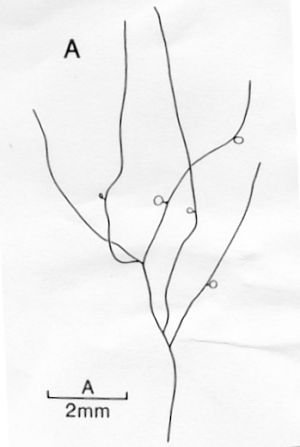Elysia obtusa and its diet
July 27, 2001
From: Kathe R. Jensen

Dear Bill,
It was interesting to see that Cynthia found Elysia obtusa on Bryopsis. Like the other collectors, I have not found it associated with any particular algae (in fact, I have only collected 2 or 3 specimens in Hong Kong). Now that this species seems to be popping up a lot of places, it would be nice if someone would look for small (only a few cm long) filamentous algae, possibly with tiny bulbous structures (sporangia) attached to the sparsely branched filaments. This could be the algal genus Derbesia, which is very closely related to Bryopsis, and which can almost always be eaten by "Bryopsis -feeders". The interesting thing about this pair of algal genera is that in Bryopsis the gametophyte (which forms flagellated gametes) is the well-known, feather-like thallus, which has cell walls composed of xylan and cellulose. In Derbesia it is the sporophyte (forming diploid zoospores) which is the visible, filamentous thallus. The sporophyte cell walls are composed mainly of mannan. My theory is that the rate of speciation of sacoglossans increased, and their "adaptive radiation" to almost all siphonaceous green algae began when species feeding on filamentous Udoteacea (with xylan cell walls) switched diet to Bryopsis, and from Bryopsis either to Cladophorales (with cellulose cell walls) or to Derbesia and then to Codium (with mannan cell walls). Today few species have been recorded to feed only on Bryopsis and/or Derbesia, but many species feed on either Cladophorales plus Bryopsis or on Codium plus Bryopsis. A few, like Elysia viridis, can include the whole range of these algae.
So any more information on sacoglossans from Bryopsis and/or Derbesia would be most welcome. I would also greatly appreciate information on possible food algae of Elysia flava, from the Mediterranean, from the Canary Islands, from Bermuda or from the Caribbean.
The attached drawing of Derbesia is from Womersley, (1984). It just doen't look like much - and it is the same in the field.
Reference:
• Jensen, K.R. (1997) Evolution of the Sacoglossa (Mollusca, Opisthobranchia) and the ecological associations with their food plants. Evolutionary Ecology, 11: 301-335.
• Womersley, (1984). The Marine Benthic Flora of Southern Australia, Part I. (Fig. 100A, p. 291. Derbesia tenuissima).
Greetings,
Kathe
jensen@ait.ac.th
Jensen, K.R., 2001 (Jul 27) Elysia obtusa and its diet. [Message in] Sea Slug Forum. Australian Museum, Sydney. Available from http://www.seaslugforum.net/find/4925Thanks Kathe,
The relationship between herbivores and their plant foods is a fascinating field of study.
Best wishes,
Bill Rudman
Related messages
-
Elysia obtusa from India
From: Vishal Bhave, January 20, 2010 -
Elysia obtusa from Hawaii
From: Keoki Stender, June 22, 2006 -
Elysia obtusa from South Korea
From: Dong Bum Koh, June 9, 2005 -
Re: Development in Elysia obtusa
From: Jun Imamoto, September 25, 2002 -
Re: Development in Elysia obtusa
From: Kathe Jensen, September 16, 2002 -
Post-settlement juveniles of Elysia obtusa
From: Jun Imamoto, September 14, 2002 -
Habitat of Elysia obtusa
From: Nishina Masayoshi, July 29, 2001 -
Elysia obtusa from the Marshall Ids
From: Scott Johnson, July 28, 2001 -
Elysia obtusa from Heron Island
From: Julie Marshall, July 26, 2001 -
Another photo of Elysia obtusa
From: Nishina Masayoshi, July 26, 2001 -
Re: Elysia obtusa from Japan
From: Cynthia Trowbridge, July 26, 2001 -
Elysia obtusa from Japan
From: Nishina Masayoshi & Chikako, July 25, 2001 -
Elysia obtusa from Hong Kong.
From: Leslie Chan, July 25, 2001 -
Elysia obtusa from Hong Kong
From: Bill Rudman & Brian Darvell, July 25, 2001
